Original: The Secret Sauce of Hyperliquid
Author: @stacymuur (CuratedCrypt0), zhouzhou (BlockBeats)_
Editor's Note: This article was published in March 2025, at which time Hyperliquid was in the spotlight due to the frequent contract operations of the "50x leverage insider whale." Two months later, as the cryptocurrency market began to recover, Hyperliquid stirred the market once again, with its token $HYPE reaching a new all-time high. The whale player bringing attention to Hyperliquid this time is James Wynn, a high-profile "40x leverage whale."
On May 26, whale James Wynn posted on social media, hinting that he would no longer participate (or publicly engage) in contract trading, stating:
"To all supporters and haters: Our journey in this long gamble has been quite good, with the account peaking from 3-4 million in principal to 87 million. Now I have decided to exit with a profit of 25 million. This game has been enjoyable, but it’s time to exit as a winner; Wynn and the haters are now 1:0."
BlockBeats previously reported that whale James Wynn recently attracted significant attention on Hyperliquid by opening long and short positions worth over 1 billion dollars. Last weekend, Wynn opened large short positions betting on a decline in Bitcoin, ultimately exceeding a position value of 1 billion dollars again. Earlier today, Trump changed his stance again, delaying the imposition of a 50% tariff on the EU, triggering a rapid rebound in Bitcoin, which led to his short positions ultimately closing with a loss of over 15 million dollars.
Why are whales keen on Hyperliquid? This decentralized derivatives platform, with leverage up to 50x, zero gas fees, and a fully on-chain transparent order book, has become a paradise for high-risk traders. The platform's low cost and high leverage, combined with market volatility, have attracted whales, making Hyperliquid the new focus of contract trading.
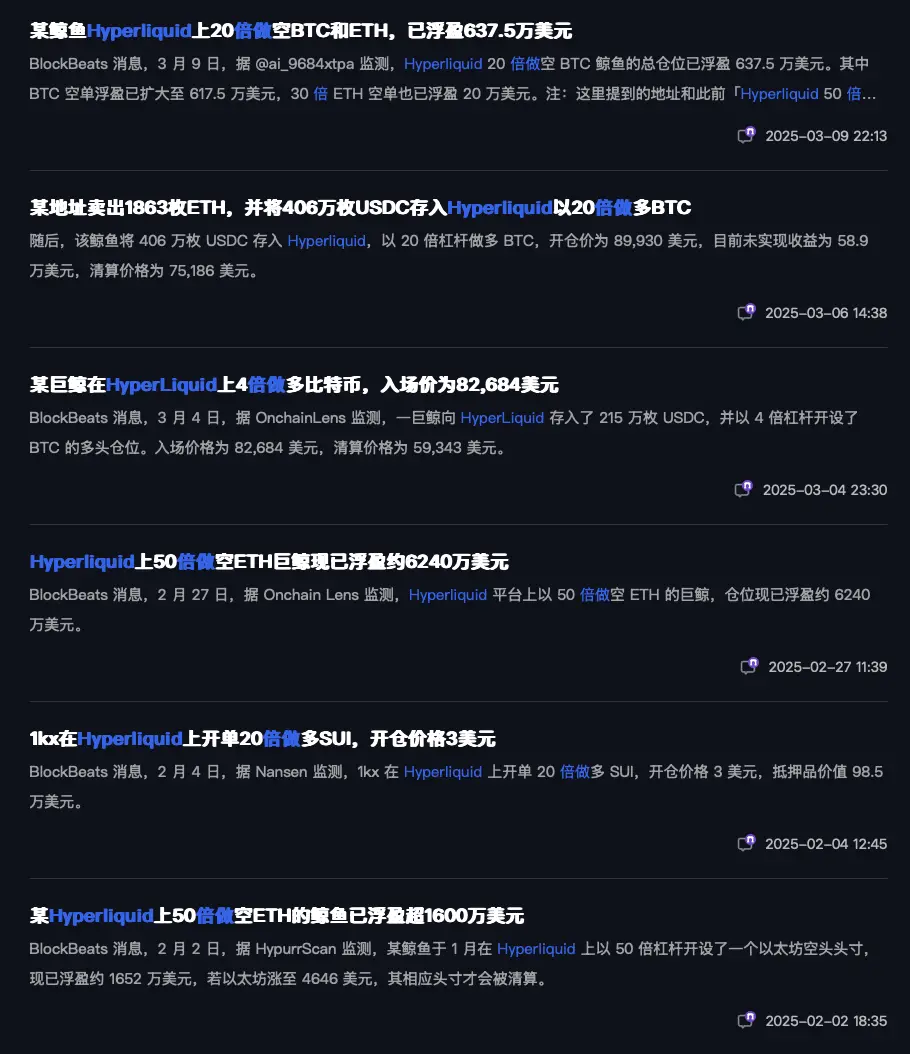
The following is the original content (reorganized for readability):
In the history of DeFi derivatives, few protocols have managed to capture more than half of the on-chain perpetual contract market, yet Hyperliquid has achieved this. What is its secret?
Data shows that within 24 hours, the total trading volume of on-chain perpetual contracts was 14.37 billion dollars, with @HyperliquidX accounting for an astonishing 9.3 billion dollars, representing a staggering 64.71%, demonstrating Hyperliquid's absolute dominance in the market.
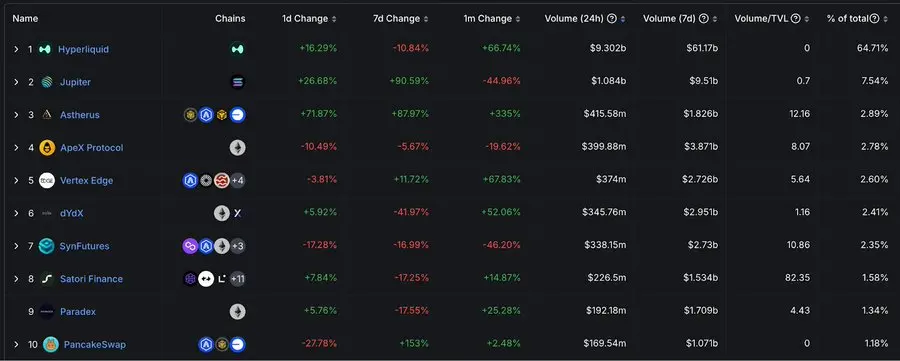
However, most DEXs have struggled to match these aspects, often relying on:
- AMM design (leading to excessive slippage on large orders, e.g., GMX);
- Partial off-chain solutions (like dYdX v3), which can affect transparency or increase user complexity.
Hyperliquid recognized this issue: if the user experience is poor or liquidity is insufficient, users will not migrate en masse to on-chain. Therefore, the team is committed to providing "CEX-level speed and liquidity, but fully on-chain."
Hyperliquid's success proves the potential of DEXs in the face of giants like Binance. Binance's 24-hour perpetual contract trading volume is 97.22 billion dollars, while the overall trading volume of DEXs is only 14.637 billion dollars, with Hyperliquid contributing 9.532 billion dollars.
With Hyperliquid, DEX trading volume can reach 15% of Binance's; without it, this ratio would drop to 5%, leaving only 5.105 billion dollars. This demonstrates Hyperliquid's role in driving DeFi trading.
This performance fulfills Hyperliquid's core promise—providing a CeFi-level trading experience on a fully decentralized Layer-1.
Background and Founding Story
Origins and Team Composition
Hyperliquid was founded by @chameleon_jeff (a Harvard graduate and former quantitative trader at Hudson River Trading) and a small engineering team from top institutions like MIT and Caltech.
They engaged in high-frequency trading (HFT) from 2020 to 2022 and shifted to trustless solutions after the collapse of FTX. Witnessing billions of dollars disappear due to centralized custody, their goal became clear: to create a self-custodial alternative that does not sacrifice performance, choosing a "no VC, self-funded" approach to ensure long-term alignment with users and traders rather than catering to short-term investor interests.
Why do CEXs still dominate?
Despite the collapse of major CEXs like FTX, user trading habits did not immediately shift to DeFi. Many traders still use centralized platforms like Binance, not because they ignore custody risks, but because CEXs consistently offer:
- Fast and familiar interfaces
- Deep liquidity
- Advanced trading features (stop-loss orders, professional candlestick charts, etc.)
- No gas fees, seamless cross-chain transactions
- Low barriers to entry and convenient trading experiences

The data from November to December 2022, following the FTX collapse. The 2025 data is an estimate as of March 6. Hyperliquid recognized this shortcoming: if the user experience is poor or liquidity is insufficient, users will not migrate en masse to on-chain. Therefore, the team is dedicated to building "CEX-level speed and liquidity, but fully on-chain."
Prioritizing User Experience in Product Development from Day One
Let’s take a look at Hyperliquid's product matrix:
- Perpetual Contract DEX
Hyperliquid's core product is its perpetual contract DEX, which uses a fully on-chain central limit order book (CLOB) and supports:
- BTC, ETH up to 50x leverage
- SOL, SUI, kPEPE, XRP up to 20x leverage
- Small-cap tokens up to 3x leverage
Hyperliquid was built from the ground up, offering greater openness than competitors' off-chain solutions and specifically designed for high-frequency trading (HFT) needs. Its features include:
- Sub-second trade confirmations
- Processing 100,000 orders per second
- No gas fees or near-zero gas fee experience for placing and canceling orders
These key factors make its user experience comparable to CEXs.
Advanced Trading Mechanisms
- Atomic operations: Support for atomic liquidation based on the latest oracle prices, with atomic funding rates distributed hourly.
- Asset security checks: The platform verifies asset security at the end of each block.
- Order prioritization: Prioritizes the cancellation of orders and limit orders, protecting market makers from malicious liquidity impacts.
As of last week, the trading volume of Hyperliquid Perps reached 66.5 billion dollars, nearly seven times that of the second-ranked Jupiter (9.7 billion dollars) and exceeding the total of the next 14 competitors (33.6 billion dollars).
Hyperliquid dominates 66% of the total trading volume of the top 15 perpetual exchanges.
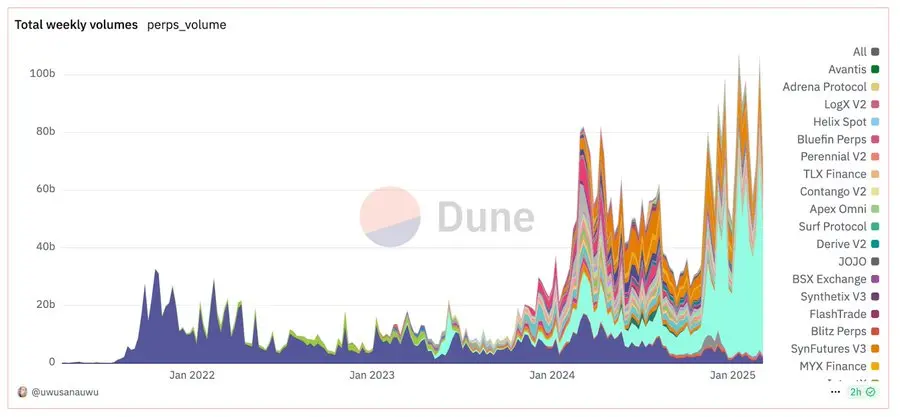
- Spot Exchange
Hyperliquid's spot exchange launched in mid-2024, initially supporting over 20 native assets such as HYPE and memecoins.
Compared to Hyperliquid's massive 1.06 trillion dollar perpetual contract market, spot trading started small but is growing rapidly. By early 2025, with key updates (especially the launch of BTC), Hyperliquid is gradually becoming a strong competitor in on-chain spot trading.
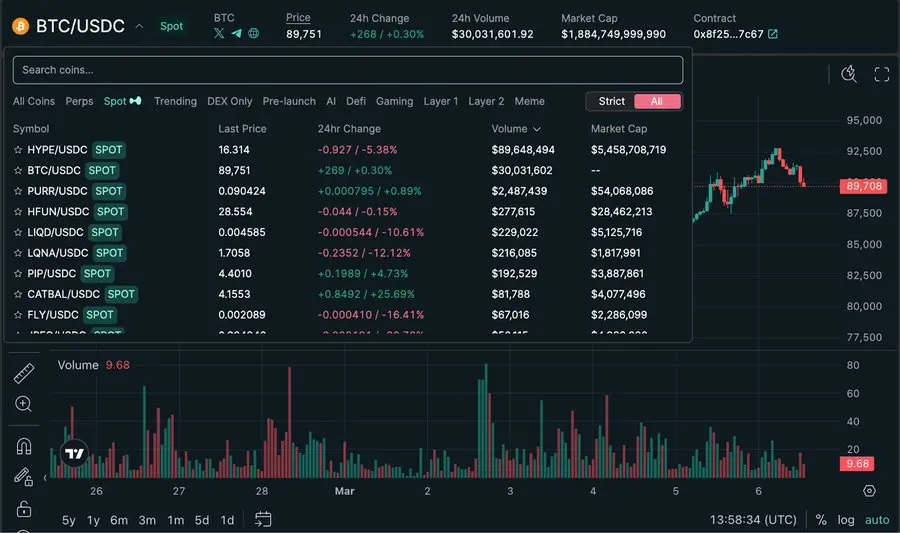
Back in mid-2024, Hyperliquid's spot trading was limited to its own tokens and a few other assets (like RAGE). This limited asset range deterred many professional traders, who preferred mainstream assets like BTC rather than just speculative tokens.
Messari analyst MONK predicted in his report that if Hyperliquid added BTC, it would completely change the landscape, making it a one-stop platform covering both spot and derivatives trading, challenging centralized exchanges. This prediction was quickly validated on February 15, 2025—when the Unit team launched the feature to trade BTC spot directly on the Hyperliquid order book.
What does this mean?
- Surge in trading volume: Before the launch of BTC, Hyperliquid's spot trading volume was only a small fraction of the monthly 63 billion dollars in BTC perpetual contract trading volume. Messari estimates that with the right assets introduced, spot trading volume could reach 20%-30% of perpetual contract volume, with potential increments in the billions of dollars. With the launch of BTC spot, other DEXs already have 33 billion dollars in monthly BTC trading volume, and Hyperliquid is rapidly capturing this market share.
- More assets are set to launch: The Unit plan not only supports BTC but also lays the groundwork for future introductions of ETH, SOL, and even real-world assets. This could position Hyperliquid as a core market for cryptocurrency asset spot trading.
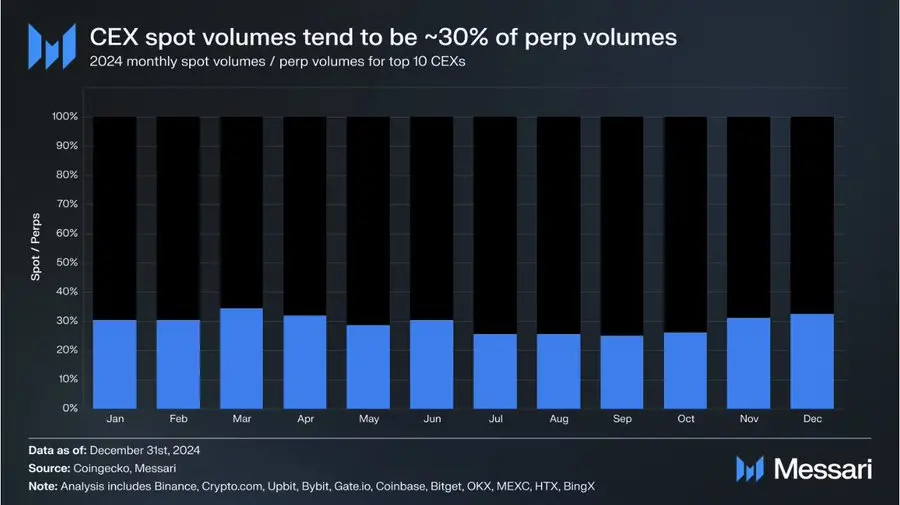
- Hyperliquid HLP (Liquidity Vault)
HLP is a liquidity vault where users can deposit funds (mainly USDC) to act as counterparties for derivatives exchange traders and earn a share of the trading profits.
- Purpose: To provide passive income opportunities for users who do not wish to trade actively, following the model of "the house always wins," allowing depositors to benefit from trading activities.
- Core Features: The funds deposited by users are lent to traders for leveraged trading. Returns fluctuate, but at the end of 2024, the annualized return once reached 54%.
- Vaults (Copy Trading)
Hyperliquid offers a copy trading (Vaults) feature that allows users to allocate funds to the strategies of professional traders for automated trading.
- Purpose: To enable ordinary users to profit from the expertise of top traders without having to operate directly.
- Core Features: Anyone can create a Vault and manage funds, with managers required to hold at least 5% of the position and entitled to 10% of the profit share. Users can browse the performance of different Vaults, choose investments, and achieve profit sharing.
- HIP-1 and HIP-2 Token Standards
Hyperliquid has launched two innovative token standards to enhance its ecosystem:
- HIP-1: A native token protocol that allows users to issue custom tokens on Hyperliquid L1 (e.g., PURR, a meme coin launched as a proof of concept).
- HIP-2: A liquidity solution that provides market-making strategies for tokens issued under HIP-1, ensuring liquidity without relying on external platforms like Raydium (unlike Pump.FUN).
Core Features:
- HIP-1 tokens can be directly used for Hyperliquid's spot and perpetual contract trading.
- HIP-2 is custom market-making by the Hyperliquid team, leveraging its quantitative trading capabilities to provide liquidity support.
Example: PURR features a native ledger, spot order book, built-in oracle, and perpetual contract trading, demonstrating how these standards build a composable trading ecosystem.
The Technical Core of Hyperliquid
From perpetual contracts to spot trading, all of Hyperliquid's products are built on its custom blockchain—Hyperliquid Layer1. On February 18, 2025, HyperEVM officially launched on the mainnet.
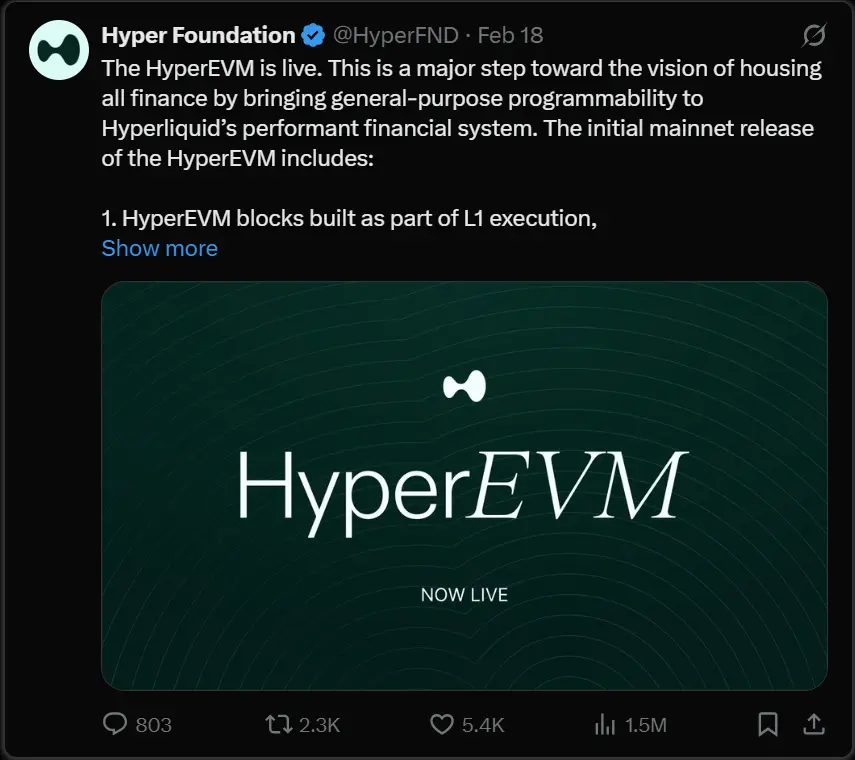
Hyperliquid's blockchain currently handles over 20,000 transactions per second (TPS), supporting a robust ecosystem that includes perpetual contract trading and the BTC spot market. Based on HyperBFT consensus, its L1 has evolved from a specialized trading platform to a general-purpose blockchain.
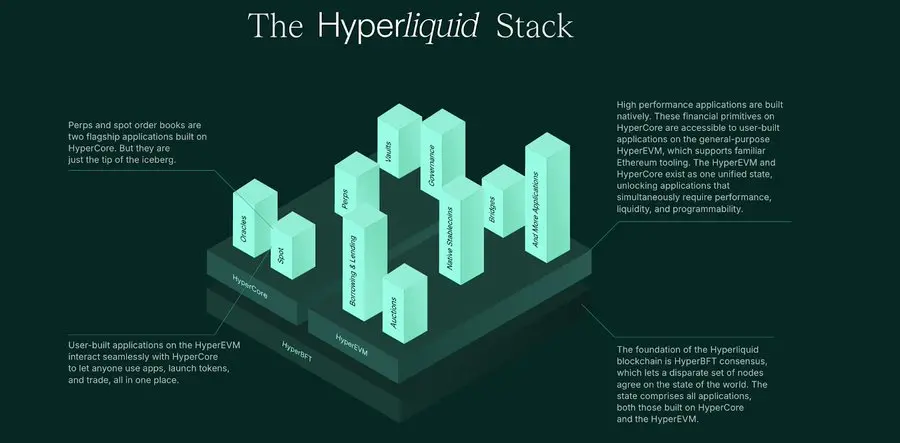
Key Optimizations of HyperBFT
Significant TPS Improvement: Previously limited by Tendermint to 20,000 orders per second, the upgrade allows for 200,000 orders per second.
Faster Processing Speed: The consensus process is not hindered by execution delays, allowing transactions to be continuously ordered without waiting for the current block to complete execution.
Lower Latency: Confirmation times are faster and more stable, only affected by network latency.
Optimistic Response: Block generation speed depends on the communication efficiency of validators.
HyperEVM: Complete Layer-1 Capabilities
HyperEVM integrates a general EVM network into the Hyperliquid blockchain state, forming a dual VM architecture:
Native VM: Optimized for high-performance trading.
EVM Layer: Supports permissionless third-party development.
The upgrade of HyperBFT, along with the introduction of BTC spot trading, is gradually making Hyperliquid a more powerful and versatile trading platform.
How Does Hyperliquid Compare to…?
Hyperliquid vs. Other DEXs
Fully On-Chain vs. Partially Off-Chain
Hyperliquid employs a fully on-chain central limit order book (CLOB), while many DEX competitors (like dYdX v4) still rely on partially off-chain order books. Hyperliquid's solution ensures verifiability and a transparent matching engine, avoiding opaque operations and front-running issues.
Dominance in the Perpetual Contract Market
As of February 2024, Hyperliquid has captured 56% of the on-chain derivatives DEX trading volume. Since July 2024, its monthly perpetual contract trading volume has surpassed major competitors. In January 2025, Hyperliquid's monthly perpetual trading volume reached 196 billion dollars, while the total of the other four major protocols was only 60 billion dollars.
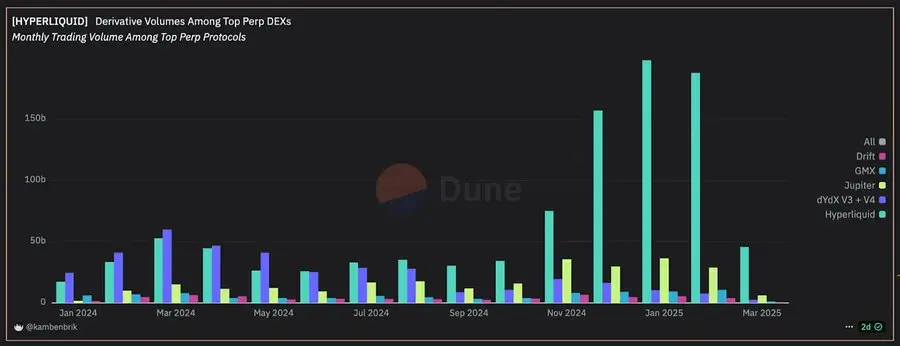
Performance and Market Maker Priority
Hyperliquid's custom Layer-1 and consensus mechanism (HyperBFT) enable it to handle sub-second latency and approximately 100,000 orders per second. This is specifically tailored for high-frequency trading. Other DEXs based on general-purpose blockchains must share block space with many other transactions, making it more challenging to maintain high throughput.
Comparison with CEXs
Volume Gap and Growth Trajectory
Although Hyperliquid is still smaller than top CEXs like Binance, it has narrowed the gap in certain months, and by March 2025, its trading volume accounted for over 26% of the total displayed trading volume (compared to the top 100 spot trading pairs on Binance). This comparison highlights how a high-performance on-chain perpetual contract exchange can effectively challenge or even dominate centralized spot markets.
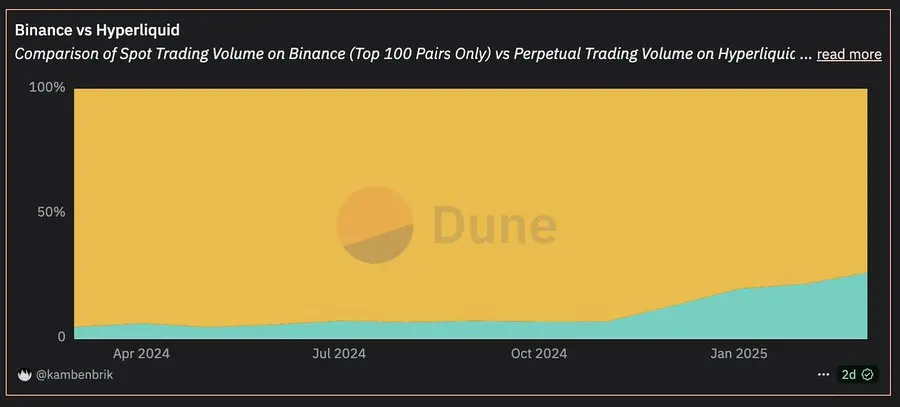
On-Chain Transparency vs. Centralized Control
CEXs often have proprietary off-chain engines that may lack transparency in order routing, fees, or front-running. Hyperliquid's fully on-chain design allows anyone to verify transactions in real-time.
Future Goal: "On-Chain Binance"
Analysts describe Hyperliquid's bullish scenario as evolving into an on-chain Binance analogy. It has already provided perpetual contracts and an expanding spot market, recently launching spot BTC, and HyperEVM is now running on the mainnet, beginning to attract a broader range of DeFi applications. After becoming a product leader in the DeFi derivatives space, Hyperliquid's rapid success relies not only on its performance but also on its community-first philosophy.
Hyperliquid's Community: A Trading Platform Built for Traders
Community-First Token Distribution
- No-Risk Investor Holdings: Hyperliquid's team developed the platform through self-funding, avoiding private investor allocations. This ensures that tokens are not diluted by large venture capital shares, contrasting sharply with competitors like dYdX (over 50% to investors) or GMX (30% to insiders).
- Generous Airdrop: The genesis airdrop (31% of the supply): Distributed to 94,000 early users, averaging about 45,000 dollars per person. This rewards real users rather than speculators.
- Points Program: An opaque reward mechanism suppresses Sybil attacks, favoring loyal users over bots.
- 76% Community Allocation: Over three-quarters of the $HYPE tokens are allocated to the community (airdrops + incentives), ensuring alignment with long-term growth.
- Listening to Users: Direct feedback builds a community with shared interests. The team reached out to traders like @HsakaTrades (500k+ followers) and @burstingbagel via private messages, establishing Vaults (e.g., Delta-neutral strategies with 20%+ annualized returns) and HLP based on feedback. Since 2024, over 50% of feature updates have come from user requests, making traders co-creators rather than just users.
- Building Trust Through Reliability: A reliable product retains users in a skeptical market. Traders initially came for the airdrop but stayed because Hyperliquid offers one-second deposit speeds, deep liquidity in HLP, and 99.9% uptime, unlike competitors that frequently experience downtime.
Hyperliquid is not the first DEX to launch perpetual contracts, but by optimizing trading speed (sub-second order execution), liquidity (HLP pools exceeding 540 million dollars), and user experience (addressing withdrawal delays overlooked by competitors), it has achieved 100,000 daily transactions, successfully countering the claim that "dYdX or GMX have already 'ended' the derivatives market."
Assistance Fund
When traders use the Hyperliquid platform, they pay trading fees, a portion of which is allocated to the Assistance Fund (AF). This fund continuously purchases HYPE tokens from the market, creating sustained buying pressure. As trading volume increases, more fees flow into the AF, further driving demand for HYPE. To date, the AF has accumulated 16.63 million HYPE tokens, accounting for 4.97% of the circulating supply, currently valued at approximately 267.24 million dollars. Hyperliquid's rapid growth is evident, with perpetual trading volume reaching 196 billion dollars in January 2025.
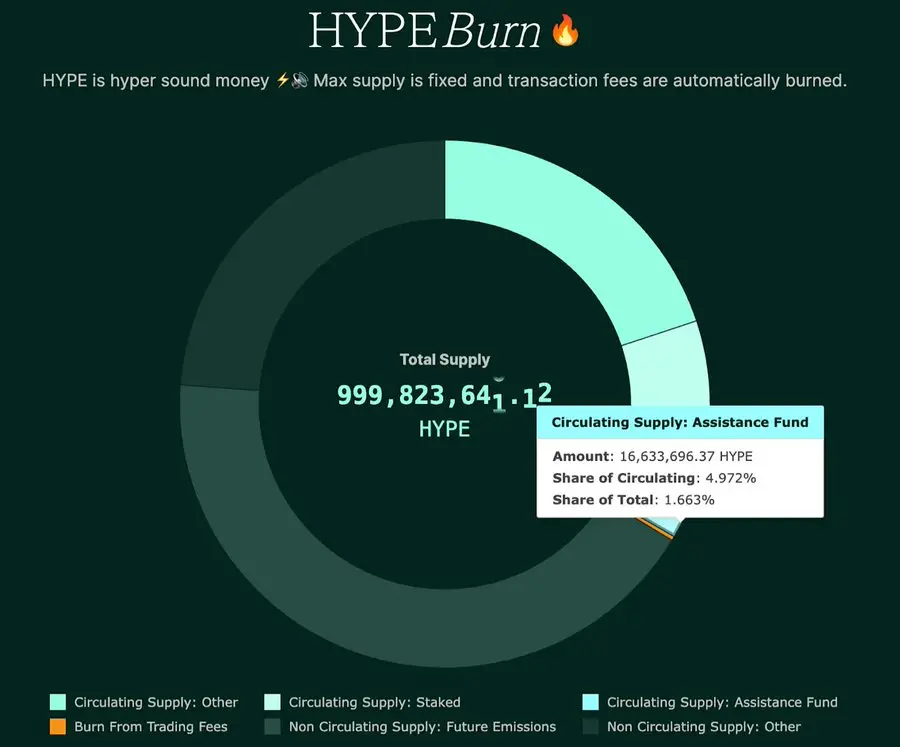
What Does This Mean for End Users?
For HYPE holders and traders, this system creates a self-reinforcing value loop. As Hyperliquid's trading activity grows (as shown in the chart below), the purchasing power of the Assistance Fund will also increase, ultimately benefiting long-term token holders.
Self-Reinforcing Loop: More Trading → More Fees → More Buybacks → Token Value Increase.
User-Centric Product Design
- Gas-Free Trading: Gas fees are only incurred when trading activity increases (e.g., listing a spot or transferring to a new wallet).
- No KYC Required: Registration can be done via email or crypto wallet (like MetaMask).
- Intuitive Interface: Designed for both beginners and advanced traders, the interface resembles centralized exchanges (like Binance).
- Near-Instant Settlement: Sub-second block times support real-time trading.
- High Throughput: Processes over 200,000 transactions per second, with no delays even during peak activity.
- Easy Fund Deposits: Recharge USDC via Arbitrum (with plans to support native multi-chain in the future).
- Gamified Design: Leaderboards and competitive rewards (e.g., airdrops for top traders) create a sticky and active community.
Decentralized Path
While Hyperliquid's L1 was initially operated by team-run validators (to optimize performance and rapid iteration), it is gradually evolving towards a multi-validator network and distributed node framework:
- Expanding the validator set (increasing from 16 to over 100 nodes).
- Read-Only Nodes: Third parties can run nodes to verify the chain's state and block production.
- Long-Term Deployment Plan: As the ecosystem develops, the team plans to introduce stronger staking and validator onboarding mechanisms, moving towards a trustless model similar to leading proof-of-stake networks.
- Team Incentive Alignment: Since fees currently flow to the protocol treasury and LP providers (rather than the founding team), the team's future rewards are tied to the upcoming token, aligning with long-term chain performance and decentralization goals.
Looking ahead, Hyperliquid is evolving from a focused perpetual contract DEX to a complete exchange ecosystem. With the addition of BTC spot trading, the launch of HyperEVM on the mainnet, and the expansion of the validator set, its ambitions are clear, aiming to become the "on-chain Binance."
Combining the high performance of CeFi with the transparency of DeFi, it has captured 64.71% of on-chain perpetual contract trading volume, demonstrating how a successful community-driven approach can enable DEXs to challenge even the largest centralized platforms.
What is Hyperliquid's Secret to Success?
- No VC, self-funded model: Ensures users own tokens, reduces private sale selling pressure, and prioritizes the interests of real traders over short-term investors.
- User-Centric Token Distribution: Generous airdrops (31% of the supply allocated to early users, with approximately 76% allocated to the community), dynamic points programs to prevent Sybil attacks, and an assistance fund that benefits holders through token buybacks.
- High-Performance Layer-1 (HyperBFT + HyperEVM): Sub-second confirmations, 100k+ order throughput, and EVM compatibility provide a combination of speed and future DeFi scalability.
- Fully On-Chain CLOB: Transparent order matching and minimal slippage bridge the liquidity gap that typically binds traders in CeFi.
- One-Stop Service for Spot and Perpetual Contracts: Seamless access to core markets: newly launched BTC spot and robust perpetual products. Users can manage spot and leveraged positions on a single platform.
- Community-Driven Feature Development: Direct feedback loops (user requests for Vault, HLP enhancements, cross-chain bridging) allow traders to participate and shape ongoing improvements.
- Long-Term Decentralization Vision: Gradually expanding the validator set, opening read-only nodes, and a fee structure with no team profits ensure incentive alignment and gradual trustlessness.
By combining technical excellence, community-first incentive mechanisms, and uncompromising user experience, Hyperliquid has outlined a blueprint for success in DeFi.
Its "secret" is essentially the perfect blend of institutional-grade performance and grassroots user engagement—this combination redefines on-chain trading and paves the way for a broader future in decentralized finance.
免责声明:本文章仅代表作者个人观点,不代表本平台的立场和观点。本文章仅供信息分享,不构成对任何人的任何投资建议。用户与作者之间的任何争议,与本平台无关。如网页中刊载的文章或图片涉及侵权,请提供相关的权利证明和身份证明发送邮件到support@aicoin.com,本平台相关工作人员将会进行核查。




